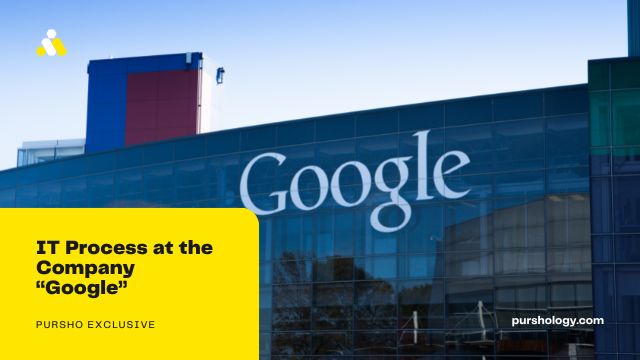Welcome to the inside scoop on Google’s IT process! With the world’s leading search engine and the most widely used operating system, Google has set the standard for software development. But what’s behind their success? Today we’re peeking behind the curtain to get an exclusive look at Google’s comprehensive IT process. Keep reading to find out how they do it, and how you can too!
Introduction
Google is known for its innovative use of cutting-edge technology in fields such as cloud computing and artificial intelligence. To ensure that their technology is always up and running, Google has developed a number of detailed IT processes to ensure the smooth operations of all their products and services. These IT processes are customized to fit the unique needs of Google, covering topics such as hardware installation, software implementation, and security management.
This article will provide an overview of the different IT processes used at Google so that readers can gain a better understanding of their approach to information technology management. We will cover IT process development, implementation, maintenance and monitoring. In each of these areas we will look at how Google ensures the reliability and efficacy of its equipment, services, and networks. Additionally, we’ll explore the roles played by various teams within the organization in managing these operations successfully.
Overview of Google’s IT Process
Google is one of the most successful technology companies in the world. As such, it has developed a comprehensive IT process to ensure maximum efficiency when it comes to how it does business. This includes everything from its data management and systems development to its security measures and customer service initiatives.
The company’s basic IT process follows four main steps: plan, build, control and monitor. In the planning phase, Google can assess the needs of its users and develop an appropriate strategy to meet those needs. During the build phase, actual papers and programs are developed based on those plans. Controls are then implemented in order to ensure that projects are meeting their goals. Finally, an ongoing monitoring system is used to measure progress over time and determine whether any changes need to be made.
This IT process allows Google to achieve maximum efficiency in everything it does, giving it an edge in a highly competitive market. All users benefit from this approach by getting continual improvements and new features that better meet their needs while minimizing costs at every step of the process. By honing its methods over time, Google ensures a bright future for itself and its customers alike.
IT Infrastructure at Google
Google is renowned for its large, sophisticated IT infrastructure that enables it to offer a variety of services. Google’s IT infrastructure consists of its networks, physical equipment such as processors, and software tools that allow it to efficiently scale up or down as needed to meet customer needs. This infrastructure is intended to maximize Google’s ability to rapidly deliver innovative products and services while minimizing cost.
Google’s IT Infrastructure comprises of wide area networks connecting data centers located throughout the world. Also, most major cities have connectivity devices connected via Google leased lines and Dark Fiber for efficient communication across the globe. This well-engineered network allows for low latency communication with select data transfer speeds guaranteed on a per-customer basis. The network connection assures a secure end-to-end transmission path for critical customer data, eliminating potential security risks associated with standard internet connections.
Additionally, Google also has an advanced wireless infrastructure that provides wireless access within their campus confines as well as public domain access through their in-house Wi-Fi hotspots at airports; this technology enhances Google’s ability to securely connect mobile users who are often away from their desks and working remotely while still providing excellent performance and reliability. Other components like VPNs, SSO’s (Single Sign On) are also used by the Company in order to upturn the works roadblock when permitting access externally or internally more securely without compromising any sort of integrity.
Furthermore, offshore customizations with tailored solutions teamed up with automated deployment strategies accelerate business processes quicker than ever imagined allowing in higher productivity levels and paving way for successful innovation strategies promising sustainable competitive advantage against market titans minimizing lag time whilst maintaining an adequate cost structure effectively managing resources thus delivering better returns on investment!
IT Security at Google
Google places an incredibly high priority on security. As a leader in cloud computing, they are deeply committed to ensuring the safety and privacy of their customers’ data. Google’s IT professionals strive to maintain a secure environment using multiple tools and methodologies, including encryption, physical security, automated monitoring and response systems, identity and access management systems, internal policy enforcement systems, user authentication methods, and incident detection technologies.
To protect customer data stored in the cloud, Google provides an industry-leading combination of powerful encryption technology with both hardware-based and application-level security features. All of the data is encrypted both in transit and at rest using Advanced Encryption Standard (AES) 256-bit keys . This level of encryption is used by electronic banking organizations globally as it helps keep all customer data safe from malicious threats.
Google utilizes its Identity & Access Management (IAM) system to identify user accounts in order to grant or restrict access to applications or services for only authorized users. This system also helps ensure that non-human entities do not gain unauthorized access to services. Additionally, advanced two factor authentication (2FA) for user accounts provides a secure solution for verifying users’ identities that enhances protection against potential phishing attempts or other forms of breach attempts. Moreover, advanced email filtering technologies are employed which can detect phishing attacks targeting customers early on so they can be resolved promptly before any confidential information is revealed.
To mitigate common vulnerabilities across systems — whether it be malicious code causing damage or network eavesdropping processes — Google has adopted advanced antivirus solutions with real time malware scanning capabilities as part of its IT process. In addition to system hardening services such as patching strategies , periodic third party penetration tests , open source software analysis protocols , malware analysis labs have been established at Google which checks any files uploaded remotely by customers or their developers.. Moreover, log inspection tools are implemented which monitor suspicious activities across networks and alert administrators upon detection anomalies identifying issues quickly as well as preventing malicious attacks against systems before any major damage has been done .
IT Support at Google
IT support at Google typically falls under their Global Infrastructure Operations team. This team is responsible for ensuring the uninterrupted performance of Google’s core systems, tools and operations. They are also responsible for providing resolution and/or coordination of most IT system incidents, including responding to outside parties, such as external vendors or other IT personnel.
Google’s Global Infrastructure Operations team is responsible for procuring, testing and deploying new hardware, software and services. In addition, they manage the architecture of the systems by analyzing trends and issues to determine optimal server placement around their global infrastructure. They also manage installation, configuration and ongoing maintenance of both physical and virtual servers including installation of new applications or upgrades; migrations; projects; training; customer service support; and troubleshooting as needed. As part of their service agreements with customers or clients, they ensure that all systems remain in compliance with customer techno-regulatory requirements.
The day-to-day activities vary depending on customer demand but they generally include monitoring and resolution of system alerts versus benchmarks established in collaboration with internal stakeholders like System Engineers Systems Analysts/Architects , etc, who may provide direction from a business requirements standpoint.
IT Compliance at Google
At Google, an effective IT compliance program is essential to ensure that the company operates in a secure and compliant manner. The IT Compliance team provides guidance on security and privacy compliance requirements, policies, processes and tools. This entails implementing monitoring tools which track user activity and system performance across core systems such as Google Docs, Chrome OS and Gmail.
The IT Compliance team is responsible for conducting regular risk assessments across designated systems and processes to identify any potential weaknesses in security measures. In order to determine the effectiveness of these measures, the team conducts internal or external audits depending on the review request or context. With the help of their insights from these reports, actions such as patching of vulnerabilities or revising restrictive policies are put into place in order to make sure that any privacy-related non-compliance issues are mitigated with appropriate controls.
The IT Compliance team also assists in detecting unauthorized access attempts by monitoring account activities through alerting mechanisms and existing security monitoring solutions. The team reviews trends in access history to detect suspicious activities by having employees acknowledge policy trainings annualy. They also manage incidents with external vendors where there has been a breach of data collected through applications used at Google. As they continuously manage audits towards achieving technical compliance standards, they drive compliance initiatives that strengthen existing processes of the organization’s technical infrastructure moving forwards
IT Automation at Google
At Google, we strive for agility, intelligence, and speed in order to scale operations and processes quickly. To achieve this goal, IT automation plays a critical role in streamlining complex and repetitive tasks. Through automation, we are able to reduce manual processes and improve productivity across industries ranging from online searches and advertising to hardware production.
Google IT Automation utilizes robotic process automation (RPA) tools to ensure that high priority tasks will be handled with speed and accuracy regardless of workload. This process enables us to automate mundane tasks such as identity management, account provisioning, network security monitoring, bug tracking, system administration, and more. We also leverage machine learning models to monitor systems for anomalies so that any changes or errors can be flagged before they become problems.
Beyond optimizing daily time-consuming administrative processes and providing data insights quickly through analytics tools like Looker, Google is also utilizing their own development environment products such as Kubernetes Engine (GKE), Continuous Integration/Delivery (CI/CD) pipelines via Cloud Build , Platformer on GCP , AppEngine , Dataflow , Machine Learning Services APIs , Cloud Natural Language API , geospatial services such BigQuery’s SQL-like syntax: BigQL . All these resources provide the ability to scale from basic application infrastructure needs up Migrate workloads from on-premises environments into the Cloud’s wide variety of virtual machine types; offer a suite of services for evaluation industry patterns or for finance teams leveraging Machine Learning Techniques tracking customer retention rates etc.; Application Runtime models provide flexibility ranging between traditional Virtual Machines or Serverless hosting configurations using containers preferences.
By utilizing IT Automation at Google through all these avenues we are able to reduce risk while improving responsiveness and agility throughout all of our IT operations.
Conclusion
The IT process at Google has become increasingly streamlined over the years, leading to faster and smoother operations throughout the organization. By using automated scripts and tightly controlled security measures, it is able to consistently deliver information technology services with maximum efficiency. This efficient structure allows Google to remain competitive in an ever-evolving world of technology.
In conclusion, Google is a leader in the realm of IT processes due to its detailed and smartly designed methods of dealing with technology-related issues. By taking into account both internal operatives’ needs as well as external regulatory requirements, they have created an effective system that is easy to use but still remains secure. In addition, their standardized processes have enabled them to make business decisions quickly and accurately, leading to better outcomes for both customers and employees alike.




